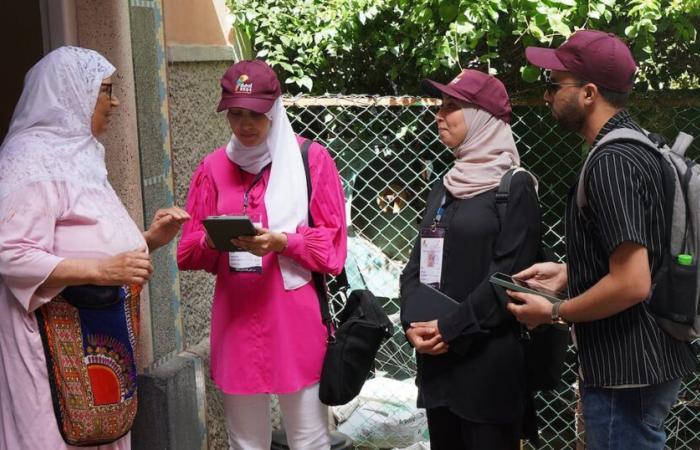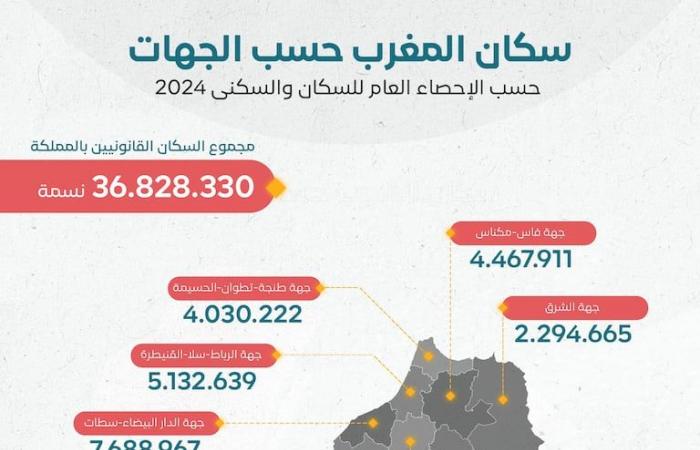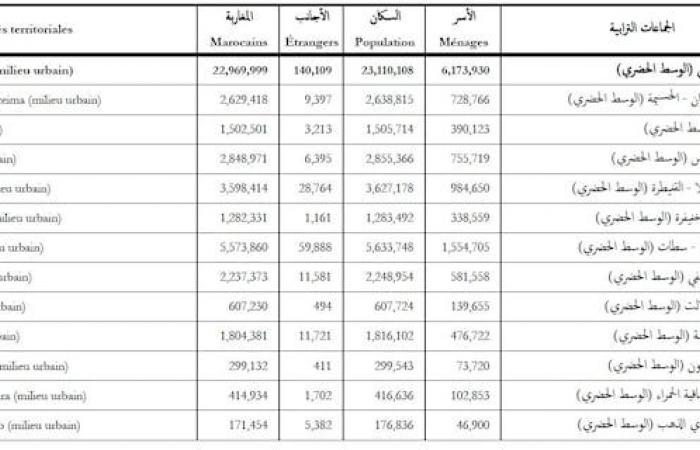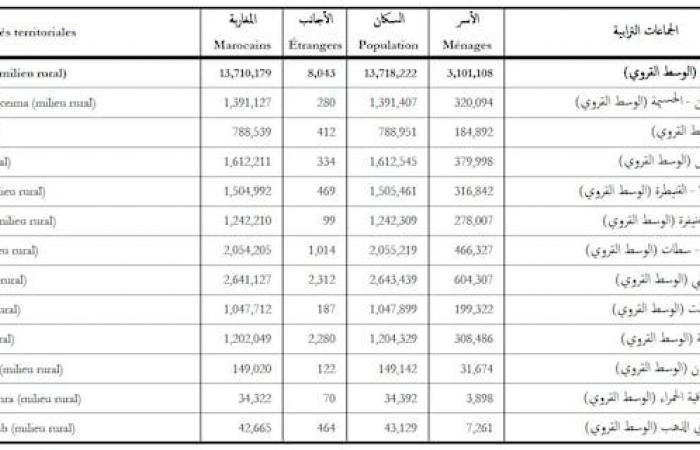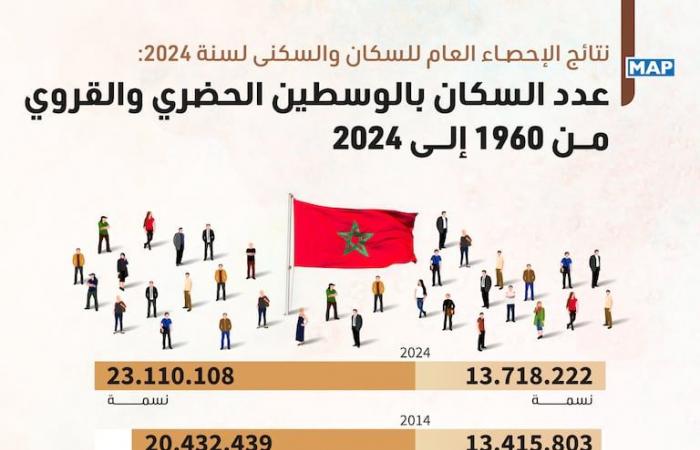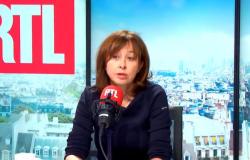The results of the 2024 General Population and Housing Census showed that Morocco witnessed important demographic transformations during the past decade, as the Kingdom’s population increased to 36.8 million people, with a total increase estimated at 2.98 million people since 2014, with an annual growth rate of 0.85%, compared to 1.25%. During the previous decade.
1- 40% of the population is distributed among 7 major cities
The census results highlighted that seven major cities accommodate 37.8 percent of Morocco’s urban population, reflecting the continuing urban expansion and population growth in urban areas.
The city of Casablanca came in the lead with a population of 3 million and 236 thousand people, followed by Tangier with 1 million 275 thousand people, Fez with 1 million 183 thousand people, Marrakesh with 1 million 15 thousand people, Salé with 945 thousand people, Meknes with 562 thousand people, and Rabat with 516 thousand people.
2- Five regions occupy 71% of the population
Five regions accounted for more than 70% of the Kingdom’s population. The Casablanca-Settat region came in the lead with 20.9% of the total population of the Kingdom, with 7 million and 689 thousand people, followed by the Rabat-Salé-Kenitra region with 5 million and 133 thousand people, then the Marrakesh-Safi region with 4 million and 892 thousand people, and the Fez-Meknes region. With 4 million and 468 thousand people, and the Tangier-Tetouan-Al Hoceima destination with 4 million and 30 thousand people.
3- Increasing rate of urbanization
Although the urbanization rate rose to 62.8 percent in 2024 compared to 60.4 percent in 2014, the disparity between regions is clear, as the highest urbanization rates were in Laayoune-Sakia El Hamra (92.4%), Dakhla-Oued Eddahab. (80.4%), and Casablanca-Settat (73.3%). The lowest rates of urbanization were in Marrakesh-Safi (46%) and Draa-Tafilalet (36.7%).
Population growth data also showed disparities between regions, as Casablanca-Settat, Rabat-Salé-Kenitra, Tangier-Tetouan-Al Hoceima, Marrakesh-Safi, and Souss-Massa regions contributed up to 86.2% of the total population growth.
The growth rate ranges between 0.79% in the Marrakesh-Safi region and 1.26% in the Tangier-Tetouan-Al Hoceima region, which reflects the role of these regions as major population centers of attraction.

4- The number of families has increased and their average size has decreased
Morocco witnessed a noticeable increase in the number of families over the last decade, reaching 9,275,038 families in 2024, an increase of 1,961,232 families compared to 2014, with an annual growth rate of 2.4 percent.
The analysis shows that this increase was concentrated in urban areas with an annual growth rate of 2.5 percent, while the rate in rural areas reached 2.2 percent.
In contrast, the average number of family members decreased from 4.6 individuals to 3.9 individuals at the national level, which indicates a change in the Moroccan family structure and a trend towards small families, which reflects a development in living patterns and economic and social factors that affect family composition.
5- Slow population growth in villages
The rural area witnessed a weak increase in population with an annual growth rate of only 0.22%, which is a much lower rate compared to the growth in the urban area (62.8%). This difference reflects the decline in the attractiveness of the rural environment for young people and the population in general, as many of them prefer to move to cities due to the lack of economic opportunities and services.
Data collected from the General Population and Housing Census indicate the great disparity between urban and rural areas in terms of growth and modernization, a disparity that has affected the quality of life in rural areas, where basic services and infrastructure remain limited compared to urban areas, which enhances migration towards cities and weakens Population stability in villages.
As is the case in urban areas, rural areas also witnessed a decrease in the average number of family members from 5.3 to 4.4 individuals. This decline indicates changes in rural lifestyle, as families tend to have small families.
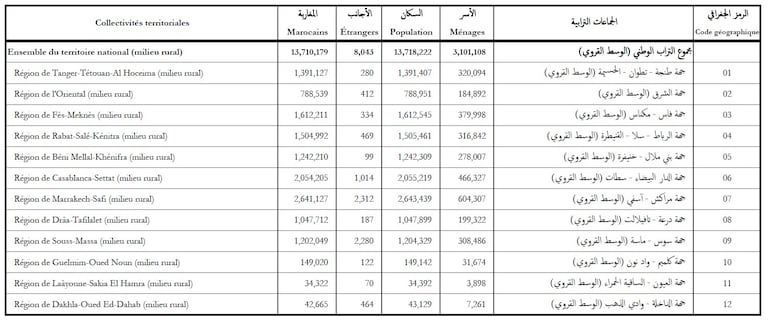
6- A noticeable increase in the percentage of foreigners
The Kingdom also witnessed an increase in the number of resident foreigners, who reached 148,152 people, an annual increase of 5.6%.
The statistics also showed that the urban population grew to 23.1 million people, an annual increase of 1.24%, while the rural population reached 13.7 million people, an annual increase of 0.22%.
7- Continuous demographic shifts since the 1960s
Since the 1960s, Morocco’s population has more than tripled, reflecting an accelerating demographic dynamism, with the urban population rising from 3.4 million in 1960 to 23.1 million in 2024, while the rural population has seen a modest increase.
This transformation indicates increasing urbanization in the Kingdom, which poses great challenges and opportunities for public policies and development actions.

The meanings of numbers and future challenges
These numbers show several challenges for the future, including meeting the needs of increasing urban growth, planning infrastructure suitable for rapid expansion, in addition to policies aimed at supporting rural areas that are witnessing a lower growth rate than their urban counterparts. Data on the decreasing size of families is also an opportunity to study the reasons for this shift, which may indicate new social and economic changes in Moroccan society.
The 2024 General Population and Housing Census provides a comprehensive overview of the major demographic transformations in Morocco, which contributes to developing an integrated strategic vision for the coming years, and helps direct public policies in line with the needs of the growing population and growing urban challenges.
Edited by Miloud Al Shallah
On 08/11/2024 at 14:58

